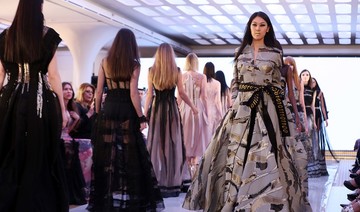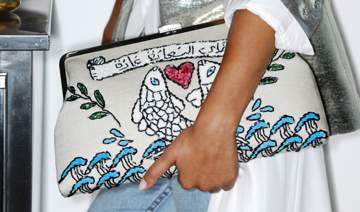NEW YORK: Bright. Vibrant. Colorful. And, most essentially, fun.
The same words used so often to describe Kate Spade’s enormously popular handbags — “It” bags that were both aspirational and affordable — were an apt description of the woman herself, say many in the fashion world. And that only contributed to the sense of shock and loss in the industry upon hearing the news Tuesday that Spade had apparently taken her own life at 55.
“She was always just as happy and delightful as her collection was,” said Fern Mallis, industry consultant and former director of the Council of Fashion Designers of America during Spade’s rise to success in the 1990s. “She was every bit the representation of that brand, and the fun of it all.”
Indeed, Spade had said it herself: “I hope that people remember me not just as a good businesswoman,” she told Glamour magazine in 2002, “but as a great friend — and a heck of a lot of fun.”
Spade was found hanged in the bedroom of her Park Avenue apartment Tuesday morning in an apparent suicide, law enforcement officials said.
Spade liked to say that she wasn’t obsessed with fashion, or interested in trends. She tried jeans, for example, decided they didn’t look good on her, and moved on. “I grew up in the Midwest, where you have to have (a fashion item) because you like it, not because you’re supposed to have it,” she told The AP in 2004. “It’s an adornment, not an obsession.”
And a Kate Spade bag was an adornment that was, crucially, affordable, unlike other iterations of “It” bags whose status seemed to hinge on the price tag. “It was a real shift,” Mallis said. “Everybody had Kate Spade bags. You could afford them, and happily buy more than one. They were affordable AND terrific AND fabulous.” Having a Spade bag “was a sign that you were in the know,” said Eric Wilson, fashion news director at InStyle. “You associated yourself with this fun, cool, with-it, hip brand that wasn’t snobbish or so exclusive that it felt like a European luxury brand.”
And the bags seemed to effortlessly appeal to a variety of women. “She had a quirky visual language that captivated Bat Mitzvah girls and artists alike,” wrote actress Lena Dunham on Twitter. “She was also a staple of NYC who spread goodwill.”
Born Katherine Brosnahan, Spade grew up in Kansas City, Missouri. She was working as an accessories editor at Mademoiselle magazine when she launched her company with husband Andy in their New York apartment in 1993, based on six shapes of bags she thought every working woman needed. She called them her “stepping stones” — and said years later that they were still her favorites.
As her brand expanded, “the fun, colorful, bright designs she created added an element of cheerfulness others have tried to emulate,” said Deidra Arrington, associate professor of fashion design and merchandising at Virginia Commonwealth University. “She was a visionary.” One obvious measure of her influence was the number of counterfeit Kate Spade bags one could find on the streets, Arrington said. “Most women remember their first Kate Spade bag. I still have mine.”
Indeed, on social media, many women were recalling their first Spade bag. “My grandmother gave me my first Kate Spade bag when I was in college,” Chelsea Clinton wrote on Twitter. “I still have it.” Jenna Bush Hager wrote: “I will never forget the first Kate Spade bag I got for Christmas in college.”
Spade was not only about bags: she would expand into shoes, apparel, luggage and other accessories, and stationery. “Everyone loves to get a letter,” Spade told the AP in 2006, explaining that she never used computers and had her staff print out emails. “I love sending them. I love getting them.”
Spade, who won multiple CFDA awards and was named a “giant of design” by House Beautiful magazine, walked away from her company in 2007, a year after it was acquired from the Neiman Marcus Group for $125 million by the company then known as Liz Claiborne Inc.
Coach, now known as Tapestry, bought the Kate Spade brand last year for $2.4 billion. Spade and her husband — who is the brother of comedian David Spade — started a new handbag company recently, Frances Valentine.
Wilson, of InStyle, recalled often finding her in her store, helping shoppers. “Often I would walk in and I’d see her there serving customers, not telling them ‘I’m Kate Spade’ or Kate Valentine, her other alias, but just helping people,” he said. “I found her to be just down to earth, a normal mom, talking about the trials and tribulations of raising a child and life in the city.”
Mallis, the former CFDA director, noted that the stunning news of Spade’s death came just the morning after virtually the entire New York fashion industry had gathered at the Brooklyn Museum for the glitzy annual CFDA awards. “Nobody could have ever anticipated that the next day, this was the news that would be flashing on our phones,” she said. “You just never know the demons that people are dealing with.”
Outside a Kate Spade store on Manhattan’s Fifth Avenue Tuesday, Dorothy Ruderman, who said she was a fan of the designer, compared Spade’s death to that of Robin Williams, who hanged himself in 2014. “You see someone who kind of made a career off of making people smile,” she said. “It’s sad.”
US designer Kate Spade remembered as vibrant and colorful, like her creations
US designer Kate Spade remembered as vibrant and colorful, like her creations
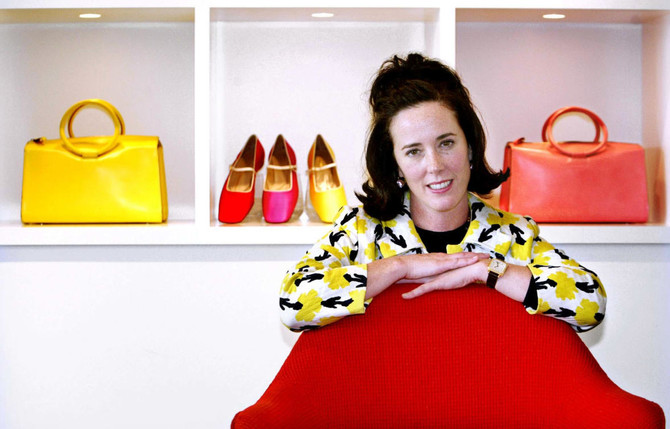
Loli Bahia, Arab models walk Chanel cruise show in France
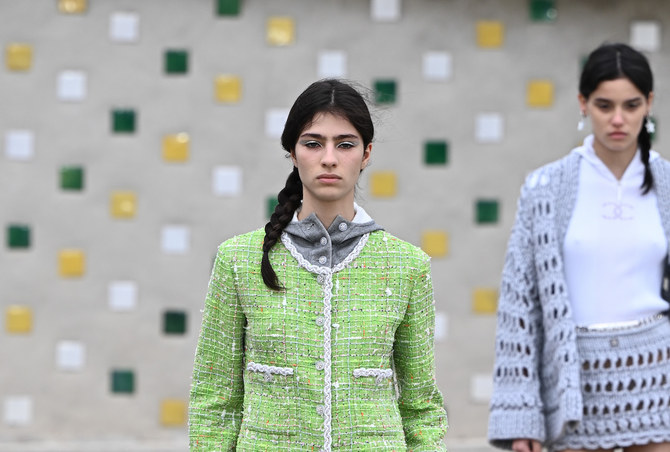
DUBAI: French Algerian model Loli Bahia, British Moroccan Nora Attal, and part-Saudi Amira Al-Zuhair took to the runway at the Chanel Cruise 2024/2025 show in Marseille, France.
Bahia donned a green ensemble, composed of a knee-length pencil skirt paired with a matching top, layered over a white shirt boasting a hoodie collar.
Attal graced the runway in a white summery dress adorned with delicate sheer geometric prints, complemented by white slippers.
Her look also featured beach-inspired layered necklaces, a thin chain belt and chunky bracelets adorned with hat, ship anchors and Chanel logo pendants.
Meanwhile, Al-Zuhair sported a vibrant yellow ensemble featuring hot shorts paired with a button-down top and a coordinating cardigan.
She also wore a beige hat, a gold choker embellished with blue detailing, chunky earrings and a chain belt adorned with pendants.
From intricate embroideries to dazzling sequined jackets and swimwear, Creative Director Virginie Viard’s latest collection showcased ensembles inspired by an underwater reverie.
The outfits included knee-length Bermuda shorts, high-waisted shorts, loose trapeze dresses, and large outerwear. Viard also demonstrated the power of layering, using shirt collars, French cuffs and jackets in unexpected ways throughout the collection.
Earlier this week, Chanel shared a series of images, captured by British photographer Jamie Hawkesworth, on Instagram featuring Bahia. The pictures, drawing inspiration from the seaside and scuba diving, provided an initial preview of Viard’s collection.
Bahia showcased multiple ensembles from the collection in the photographs. In the first shot, she dazzled in a glitzy black sequined mini pencil skirt and blazer. Another image captured her wearing the green ensemble seen on the runway, with the hoodie of the white shirt covering her head.
Additionally, she was photographed donning a white one-piece swimsuit adorned with a black bow around the chest.
The photo series also featured Bahia in a variety of other outfits, including a vibrant white dress with colorful square-like designs, tailored shorts paired with a blazer, as well as a striped set featuring a full-length skirt and matching top.
Moroccan photographer Hassan Hajjaj captures the culture of AlUla

- The acclaimed Moroccan photographer discusses his recent show in Saudi Arabia
DUBAI: Early in February this year, Moroccan contemporary artist and photographer Hassan Hajjaj was given a reminder of just how high his star has risen. Within a few days of each other, Hajjaj had shows opening in the US, Morocco, and — as part of AlUla Arts Festival — Saudi Arabia.
Hajjaj’s playful portraiture, which incorporates vivid color, funky clothing (almost all of which he designs himself), geometric patterns, and — often — vintage brands from the MENA region, has made him internationally popular, and his instantly recognizable style has established him as one of the world’s leading photographers.
His show in AlUla consisted of images that he shot in the ancient oasis town in February 2023. That visit was initially supposed to involve shoots with around 20 local people. It’s the kind of thing he’s done a few times before, including in Oman and Abu Dhabi. “It’s always a good opportunity to get to know the culture and the people,” Hajjaj tells Arab News.
But, as he says himself, he arrived in AlUla as “an outsider,” so needed a team on the ground to persuade locals to come and sit (or stand, in most cases) for him.
“It was a bit tough, in the beginning, for them to find people,” Hajjaj explains. “But because it was during a period when lots of art things were happening in AlUla, there were lots of people coming from outside AlUla as well. So we opened it up. I basically said, ‘Just come.’
“In the end lots of people turned up, not just locals — people from Riyadh, Jeddah, and people (from overseas) too. I think I shot around 100 people over a few days. So it was a great opportunity,” he continues. “To get to shoot that many people over three days — organizing something like that for myself might take a year. So, as long as I have the energy, when I get these opportunities — you know, I’m in AlUla with this eclectic bunch of people — I’d rather go and grind it, really work hard, and have that moment.”
A Hassan Hajjaj shoot isn’t your regular portrait shoot, of course. “It’s almost like a performance,” he says. “There’s music, people dress up, it’s like a day out for them, taking them out of themselves for a few hours.”
He followed the same modus operandi in AlUla. “We got an ambience going. It was fun, there was music… I shot in this beautiful old school that was one of the first girls’ schools in Saudi Arabia, from the Sixties. Upstairs was like a museum — everything was like a standstill from the Seventies and Eighties; even the blackboards had the chalk and the writing from that time,” he says.

A crucial part of Hajjaj’s practice is to ensure that his subjects are at ease and feel some connection with him (“comfortable” is a word he uses several times when talking about his shoots). While all his portraits bear his clearly defined style, it’s important to him that they should also show something unique to the people in them.
“It’s that old thing about capturing the spirit of the person in that split second, you know? I’m trying to get their personality and body language in the image,” he says. “Quite often I’m shooting in the street, outdoors, so (the subjects) can start looking at other people, thinking, ‘Are they looking at me?’ So I usually say, ‘Listen. This is a stage I’m building for you. I’m dressing you up, and we’re going to have fun.’ Then I just try and find that personality that can come out and make the image stronger. With some people, though, saying almost nothing can be better — just getting on with it. I try to kind of go invisible so it’s the camera, not the person, that’s doing the work. The best pictures come out when there’s some kind of comfortable moment between me and the person and the camera.”
It’s the way he’s worked since the beginning — a process that developed organically, as most of his early portraits were of “friends or friends of friends.”

“There’s a comfort in that because you have a relationship with them. It made it easy,” he says. “And that taught me about how important it is to build trust with people to get into that comfortable zone. But as time went on, obviously, people could see the stuff in the press or on social media, so then people started, like, asking to be shot in that manner; maybe they’ve studied the poses of certain people and stuff like that, so they come ready to do some pose they’ve seen in my pictures. That’s quite funny.”
The work that was on display over the past two months in Hajjaj’s “AlUla 1445” is a perfect example of what he tries to achieve with his shoots. The images are vibrant, playful, and soulful, and the subjects run from a local goatherder through the AlUla football team to bona fide superstars: the US singer-songwriter Alicia Keys and her husband Swizz Beatz.
Hajjaj says he has a number of favorites “for different reasons,” including the goatherder.

“He brought in two goats and it became quite abstract when you put all of them together. I was playing with that notion of the person; you could see that’s his life and even the goats look happy,” he explains. “I wanted to make sure they had that shine in the image as well. I got some great shots of him.”
The Alicia Keys and Swizz Beatz shoot has been a long time in the making. Hajjaj first met Swizz Beatz a decade ago, and they have been in touch intermittently ever since. The idea of a shoot with Keys first came up about five years ago, but logistics had always got in the way. But since they were playing a concert in AlUla at the same time as Hajjaj was there, it finally happened, on Hajjaj’s last day, with perhaps an hour left before the light faded.
I ask Hajjaj if his approach to shooting celebrities differs from his shots of “ordinary” people.

“There’s probably not that much difference,” he says. “They’re coming into my world, so, again, it’s just making sure they’re comfortable with you and you’re comfortable with them; not looking at them (as celebrities). The only thing is you have to imagine they’ve been shot thousands of times — by top photographers, too — so they’re going to have their ways. So I just have to lock in with them and find that comfortable space between the sitter and me.”
And then there’s Ghadi Al-Sharif.
“It’s a beautiful picture. She’s got this smile, with her hand over her face. For me, that one really presents the light and the energy of AlUla,” Hajjaj says. “It captures the new generation.”
Ithra showcases Arab creatives at Milan Design Week

- The Dhahran-based cultural center took part in the prestigious Italian fair last month
DUBAI: The King Abdulaziz Center for World Culture (Ithra) participated in Milan Design Week between Apr. 16 and 21. It was the second time Ithra has taken part in the annual event — a significant entry in Italy’s cultural calendar.
Ithra was founded with the goal of developing Saudi creative talent. Noura Alzamil, the center’s head of programs, has seen its influence mushroom since the beginning and continues to be in awe of her country’s rapidly developing art scene.
“Practicing it and seeing it every day around you and reading about it in articles and seeing that interaction and conversation on a national level, is really heartwarming,” she says.

“We’ve been active for the past 13 years, in collaboration with the Ministry of Culture, doing a lot of enriching programs, activations, bringing in new content and experimenting with our community and exposing them to arts, museums theatre, films,” Alzamil adds. “To me, investing in Saudi minds helps them excel in the future. I believe heavily in taking care of young talents, supporting professionals and having a global conversation.”
Ithra also houses what it bills as the region’s first ‘Material Library,’ displaying a variety of raw design materials. “Artists are all about experimentation,” Alzamil says. “The Material Library hosts hundreds of different materials that designers can come and play with.”
A cornerstone of Ithra’s programming is Tanween, a four-day conference that showcases creative designs from university students and emerging creatives from the region. The products from the conference are then exhibited in public events, such as Milan Design Week.

“To me, and to Ithra, it’s really important to showcase our efforts and Saudi and Arab designers in such festivals. Being presented among our peers there is something that we really care about,” says Alzamil. This year, Ithra presented an exhibition of items created by MENA artists in a wide range of mediums in Milan — the first time the center has presented a full show there.
Entitled “From Routes to Roots” and presented in collaboration with Isola (a Milan-based digital platform), the show included glasswork, clay, rugs and lighting. One of the key ideas of the exhibition was to demonstrate how creatives are preserving heritage and the Earth through circular design, which helps to eliminate waste from production.
“They used a lot of integrating bio materials, natural resources, household and industrial waste to come up with these innovative designs and objects that showcase and support sustainability,” Alzamil says.

Participating creatives hailing from the Levant, North Africa and the Gulf included Marwa Samy Studio, Ornamental by Lameice, Joe Bou Abboud, T Sakhi Studio, Bachir Mohamad, Studio Bazazo, and Mina Abouzahra.
“The exhibition draws inspiration and expertise from ancestral culture pairing it with cutting-edge craftsmanship, in a demonstration of how emerging talents can breathe fresh life into the design landscape, bridging the gap between tradition and innovation,” according to a press release.
Lebanese designer Bou Abboud presented a triad of round lighting fixtures that he says pay tribute to old Qatari jewelry, particularly long necklaces.
One of the more delicate pieces on view came courtesy of Jerusalem-based Palestinian designer Lameice Abu Aker. Her light-toned vases, jugs and drinking glasses are fluid and bubbly. She showcased a molecular-looking, violet vase called “Chemistry!” On Instagram, Abu Aker’s brand posted that the piece is “the perfect fusion of art and science, crafted with precision and care by our skilled artisans. Mouth-blown, every curve and line reflects the magic of the chemical reactions that inspired its name.”
Hanging textiles were also noticeably dominant in Ithra’s display. For instance, Doha-based artists Bachir Mohamad and Ahmad Al-Emadi collaborated on geometrical, symbol-heavy, blue-and-white rugs that are an homage to traditional Gulf Sadu weaving, historically practiced by Bedouins.
“It was really exciting,” Alzamil says of the show. “The team received a lot of visitors and different players in the field. . . It’s bridging the gaps between Saudi and international communities.”
London’s Arab Film Club launches podcast focusing on Palestine

DUBAI: The Arab Film Club, a monthly gathering in London celebrating Arab cinema, launched a podcast on May 1.
Spearheaded by the club’s founder, Sarah Agha, an Irish Palestinian actress and writer, the inaugural five-episode season of the interview-based podcast will focus on Palestinian filmmakers and cinema’s role in cultural resistance.
The debut episode features Darin J. Sallam, director of “Farha,” Jordan’s Oscars entry in 2022. In other episodes, Agha interviews Lina Soualem, (“Bye Bye Tiberias”), Ameen Nayfeh (“200 Metres”) Annemarie Jacir (“Wajib”) and Farah Nabulsi (“The Teacher”).

Agha told Arab News, “It is so urgent right now to do anything and everything we can to keep talking about Palestine. So I thought, ‘Why not do some interviews with some of my favorite Palestinian directors and put them online so everyone can listen to them?”
Reflecting on Sallam’s episode, Agha highlighted the transformative potential of cinema. “She is linking educational talks with her film, and I do believe her film is like a tool of change,” the presenter said.
Agha said she found Soualem’s documentary particularly intriguing, due to its departure from the scripted films typically showcased at the Arab Film Club.

“I wanted to make an exception for Soualem’s film because it’s another portrayal of the Nakba, but in very different terrains — like, totally different,” she explained. “My father is from Tiberias, so I was also attracted to it for that reason.”
Agha believes her podcast is launching at a time when Palestinians are being censored in the arts.

“There’s been a lot of cancellations of events to do with Palestine and Palestinian narratives,” she said. “So I think the best thing that we can do is not succumb to hopelessness. The fact that they’re trying to silence voices means those voices are significant. You don’t silence something that’s irrelevant. For example, the fact that the Israeli government tried to pressure Netflix into removing Darin’s film shows that it’s important.”
Agha hopes the podcast will appeal to a diverse audience, including non-Arabs.
“That, for me, is a really big thing. If we just talk to ourselves all the time, we won’t really get any further with reaching a wider audience,” she said.
Saudi Arabia announces Red Sea Fashion Week
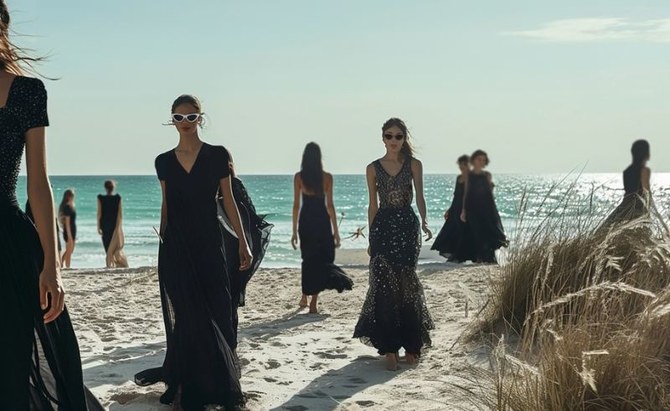
DUBAI: The Kingdom is all set to host the inaugural Red Sea Fashion Week. Set against the waters of Ummahat Island, the glitzy event is scheduled to take place from May 16-18 at The St. Regis Red Sea Resort.
Red Sea Fashion Week, which is organized by the Saudi Fashion Commission, will showcase local and international designers. It aims to celebrate the fusion of traditional Saudi aesthetics with cutting-edge contemporary design.
Among the highlights will be the participation of Saudi 100 Brands, an initiative spearheaded by the Fashion Commission to support and promote emerging local talent.
Saudi Arabia played host to its first fashion week in 2023, in Riyadh. The event took place in the King Abdullah Financial District from Oct. 20-23 and set the stage for a new fashion capital in the Middle East.


